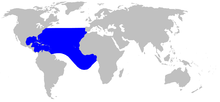- Gervais' beaked whale
-
Gervais' beaked whale 
Size comparison against an average human Conservation status Scientific classification 
Kingdom: Animalia Phylum: Chordata Class: Mammalia Order: Cetacea Family: Ziphiidae Genus: Mesoplodon Species: Mesoplodon europaeus Binomial name Mesoplodon europaeus
(Gervais, 1855)
Gervais' beaked whale range Gervais' beaked whale (Mesoplodon europaeus), sometimes known as the Antillian beaked whale, Gulf Stream beaked whale, or European beaked whale (from which its scientific name is derived) is the most frequently stranding type of mesoplodont whale off the coast of North America. It has also stranded off South America and Africa.
Contents
Physical description
This species is the largest of the mesoplodonts and rather gracile, elongated, and laterally compressed compared with the others. The mouthline is remarkably straight, even in males, and the two teeth of the male erupt towards the tip of the beak, and are hardly noticeable. The head is overall small and tapering in outline. The melon only bulges very slightly. The coloration is dark gray on top and lighter gray on bottom. Females sometimes have lighter spots near the genitals and face, with a dark circle remaining around the eyes. Juveniles start off with a lighter coloration, but soon darken. Males are 4.5 meters (15 ft) in length and females are at least 5.2 meters (17 ft) and probably weigh more than 1200 kg (2600 pounds). Calves are believed to be 2.1 meters (7 feet) in length. One beached specimen may have been 48 years old.
Population and distribution
The first stranding occurred in England, but it has since been found off Ireland, the Canary Islands, western Africa, and Ascension Island. In August 2001, a specimen was found off São Paulo, Brazil; the southernmost specimen found to date.[citation needed] The species is believed to be naturally rare, and no estimates have been attempted.
Although this species frequently strands (the first occurring in 1840), until 1998, no human had seen a living specimen. Since then, only ten other sightings have occurred.[citation needed]
Behavior
Judging by beachings, the whales occur in small groups. They probably feed on squid.
A sighting made in 1998, west of the island of Tenerife, involved three whales swimming over waters 1500 meters deep.
Another small group was seen south of the island of Gran Canaria. Although timid, the whales allowed close photos. They surfaced for a short time, and their dives lasted for around an hour.[1]
In September 2008, northeast of the island of Lanzarote, some Gervais' beaked whales were photographed breaching out of the water.[2]
May 5th 2011, one juvenile female specimen was found dead and beached at Playa Larga of Maunabo on the southeast corner of Puerto Rico (Caribbean Sea). The juvenile had her stomach filled with (10 pounds) of plastic bags. [3]
Jul 10 2011, one specimen was found dead in the Yucatan Peninsula, México, further investigation is being performed to confirm the species in this case. [4]
Conservation
The species has not been hunted and only very infrequently gets tangled in fishing nets.
References
- Taylor, B.L., Baird, R., Barlow, J., Dawson, S.M., Ford, J., Mead, J.G., Notarbartolo di Sciara, G., Wade, P. & Pitman, R.L. (2008). Mesoplodon europaeus. In: IUCN 2008. IUCN Red List of Threatened Species. Downloaded on 24 March 2009. Database entry includes a brief justification of why this species is of data deficient.
- Encyclopedia of Marine Mammals. Edited by William F. Perrin, Bernd Wursig, and J.G.M Thewissen. Academic Press, 2002. ISBN 0-12-551340-2
- Sea Mammals of the World. Written by Randall R. Reeves, Brent S. Steward, Phillip J. Clapham, and James A. Owell. A & C Black, London, 2002. ISBN 0-7136-6334-0
- A Gervais' beaked whale (Mesoplodon europaeus) washed ashore in southeastern Brazil: extra limital record? Santos, Zampirolli, Castro, and Alarenga. Aquatic Mammals 2003. 29.3, 404-410. Available: here
- Red Canaria de Varamientos (Vonk & Martín 1988; Martín & Carrillo, 1992; Martín et al. 1995;Carrillo & Martín, 2000; Carrillo & Tejedor, 2002, 2003, 2004)
- Estudios aplicados a la conservación de las poblaciones de cetáceos en la provincia de Santa Cruz de Tenerife. Informe para el Gobierno de Canarias by Carrillo, M. and Tejedor M. 2002 (Tenerife Conservación - Biblioteca pública del Centro de Planificación Ambiental de la Laguna – Tenerife)
References
External links
- ARKive - images and movies of the Gervais's beaked whale (Mesoplodon europaeus)
- Cetaceans of the World
- CMS
- Whale & Dolphin Conservation Society (WDCS)
- Sightings of Gervais' beaked whales in the Canary Islands (Spanish)
Categories:- IUCN Red List data deficient species
- Toothed whales
- Ziphiids
- Mesoplodont whales
- Fauna of the Atlantic Ocean
- Megafauna
Wikimedia Foundation. 2010.

